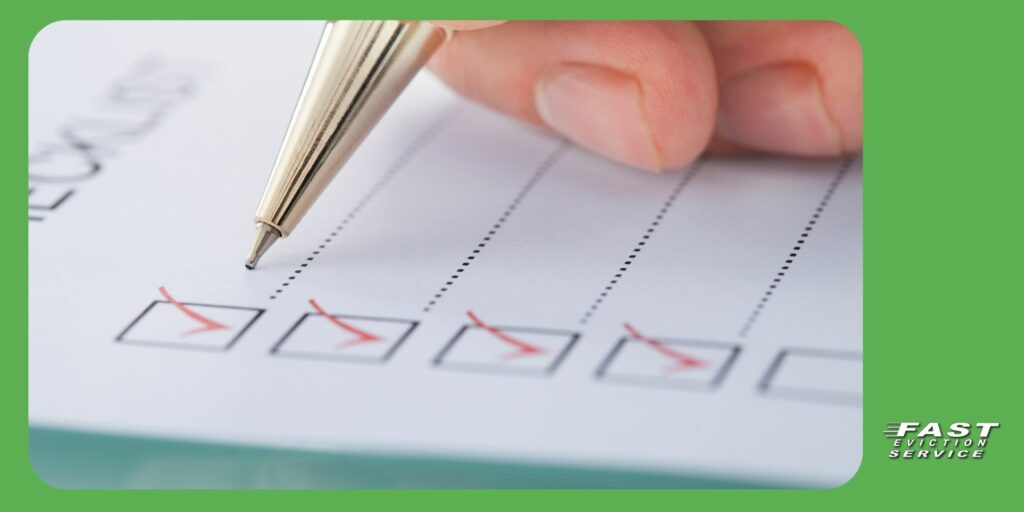You are represented at all times by one of our California Eviction Attorneys | 1-800-686-8686 | intake@fastevict.com | Se habla español
Landlord Inventory Checklist for Rental Property
If you are a landlord and have prepared your rental property inventory checklist sloppily then you can expect all sorts of expensive problems. Tenants can easily move out of the property after substantial damages done to the building or apartment and if your rental property inventory checklist wasn’t well-prepared, the tenants may not be held responsible. Tenants would neither accept the blame nor will you be able to claim for the damages. If you want to avoid such issues, read on to learn about salient tips and guidelines on how to prepare a landlord inventory for either furnished or unfurnished rental property.

What is Landlord Inventory?
It is a list of the contents of your rental property as well as a log or record of the property’s condition (including whether furnished or non-furnished). Usually, landlord inventory is referred to as a Schedule of Condition. A designated form is created that is a checklist to monitor the conditions of the property and/or the present condition of items prior to renting it to the tenants and also prior to the moving out of tenants. This landlord inventory checklist ensures that whatever damages have been done to the property/items will be compensated for by the tenant and landlord will have the right to deduct the costs of repair from the security deposit. If a landlord ignores this vital aspect of inventory documentation its highly likely disputes between the landlords and tenants may occur at the time of the tenant moving out.
How to Prepare an Inventory for Rental Property Checklist?
If you are a landlord, you can easily prepare it yourself or ask a Rental Property Management Agent or Independent Inventory Clerk to do so. The inventory for rental property checklist should and must be prepared before the tenant moves in and all the terms included in the inventory will be clearly specified to by the incoming tenant(s) and the agreement will be signed and dated by both the landlord and the tenant.
It is important to include pictorial and/or video evidence of the condition of the property and the contents/items so that it could serve as evidence as well as a comparative analysis tool when the tenant decides to move out. It’s best to include photographic or video evidence in the agreement because it adds another layer of security for the landlord.
Depending on the value of the items present on the rental out property, you can go on and capture images of each one of them. Such as, if your property is fully furnished and kitchen contains high-end appliances like dishwasher, washing machine, cooker, microwave and other electronic items then it would be a good idea to capture their images to record their condition. Then the tenant will never be able to prove that he or she is not responsible for the damages as the picture will serve as an authentic, reliable and acceptable proof.
Cross-Checking Landlord Inventory:
We recommend that landlords inspect their rental property on a regular basis. For example, you can do a property inspection on a quarterly basis. That is, after every three months’ time, in order to make a comparison between the current condition of the property/contents the landlord and the inventory checklist. However, you must not forget that you are required by California Law to send notice in writing to your tenants at least 24 hours before your anticipated inspection visit.
Once your tenant(s) informs you that the property will be vacated on a particular date they have decided to move out, it is time to make a final inventory cross-check. You need to review your landlord inventory checklist before handing over the security deposit to the tenant otherwise you may have to get into a dispute with the tenant for covering expenses of the damages done to your property (if any). Therefore, to avoid arguments and issues you must check the inventory immediately, before the tenants’ leaving date.
What Do You Do if Your Property has been Damaged?
If there are not outstanding issues and you are thoroughly satisfied with the condition after conducting a full inspection of your inventory checklist for the rental, then you can hand the security deposit back within 7 to 14 days. However, what are you supposed to do if there are damages on the property?
In that case, landlords are supposed to make an estimate of the probable costs of replacement of particular items and/or repairs. Once you have decided about the expenses involved, the tenants will have to be informed about the costs not verbally or digitally but in writing. Clearly lay out all the facts and evidence, and inform the tenant about how much amount is to be deducted from the security deposit. Usually security deposits are held by a tenancy deposit scheme. If you have followed that route then you need to inform the concerned officials regarding the expenses so that the deposit could be distributed between the landlord and the tenant accordingly.
There is also a probability that the damages are too much and security deposit cannot cover the costs of repairs and replacements. How would you deal with this situation?
In this scenario, where the security deposit doesn’t fully cover the expenses that you need to bear for the repair/replacement of your rental unit, you need to create an invoice detailing all the costs involved. In this invoice, you will deduct the amount of security deposit from the gross total and then the remaining balance will be mentioned clearly on the invoice. This will be sent to the tenant and if the tenant is insured, then the invoice will have to be sent to the insurance company.
What to do if there is a dispute?
It is possible that the landlord and tenant fail to reach an agreement over the replacement/repair issue as the tenant can blame the damages on the age of the furniture (if it is that old) and/or poor fittings, etc. This might create a problematic situation for the landlord where a clear distinction must be made between tenant caused damages and normal wear and tear of tenancy.
Here is what you need to do:
- Record the condition and state of the damage with original photographs
- Get the estimates for repairing and replacement from a professional company or technician
- Always inform the tenant in writing about the state of the contents or property after every inspection visit and keep a copy for yourself so that you could avoid issues later on
To resolve such disputes, there is a particular department in your state of residence such as the Alternative Dispute Resolution (ADR) service that is facilitated by the scheme you have signed up with for security deposit.
Even if your property is unfurnished, you must prepare the checklist of your landlord inventory because every property has some valuable items such as fittings (sinks, tubs and racks) and other fixtures like carpets, air conditioning, indoor heating cooling systems and similar items.
Be wise and always prepare the your landlord inventory checklist for your rental property with a fresh approach and new evidence whenever you change the tenant.




